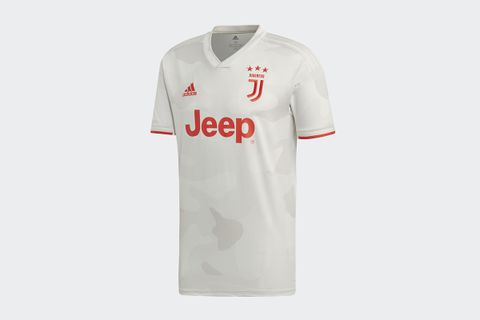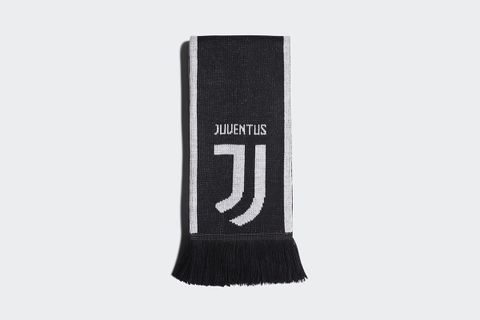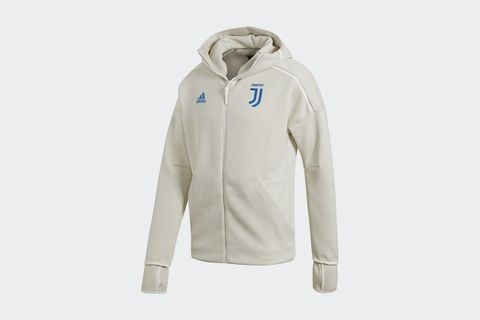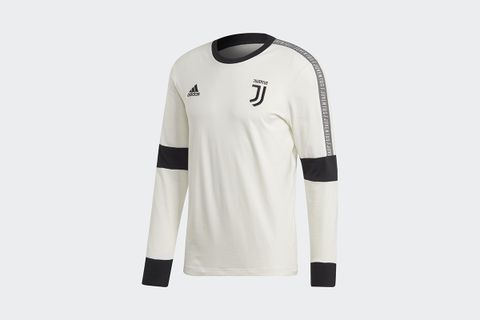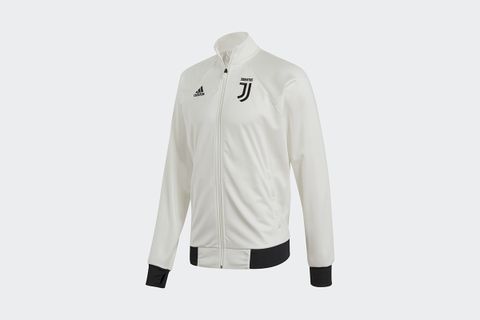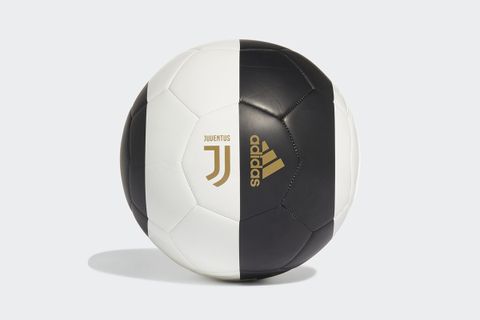Here's What Palace & Juventus' Spectacular Collab Really Means
Following Paris Saint-Germain’s wildly successful collaboration with Nike’s Jordan Brand, rumors surfaced earlier this year that Italian giant Juventus would go down a similar route by sporting Palace on its shirts via kit supplier adidas. The speculation was finally confirmed when Juventus took to the pitch against Genoa last night, wearing co-branded warm-up gear and a special-edition Palace-branded home jersey.
The announcement came out of nowhere. Juventus’ Instagram account posted photos of the team warming up before the game, cryptically hinting at the collab in the caption. When people finally realized the significance of the post, the news spread like wildfire.
The Juventus x Palace x adidas partnership is the latest marriage of performance sportswear and streetwear, following up the PSG x Jordan Brand partnership and the adidas x Palace Wimbledon tennis collab.
While the announcement came as a surprise, when one considers the zeitgeist, it makes a lot of sense. Football is no stranger to fashion, with some of its biggest stars, most notably David Beckham, blurring the lines between the two. Current day players like Hector Bellerin also enjoy a crossover appeal, while 424, Thom Browne, and Dsquared2 have made inroads into the game as formal wear partners for Arsenal, Barcelona, and Manchester City, respectively. Fashion — and by extension, streetwear — has become a potent platform for football clubs that want to reach young male audiences, particularly in North America and Asia.
The Agnelli family-backed Juventus is only too aware of the cultural overlaps in sport and fashion. Like Paris Saint-Germain, whose Jordan collab laid a marker for future lifestyle and football mashups, Juventus is a European giant trying to develop an image beyond the pitch. Juventus' status in Italy, where it has won the Serie A eight years in a row (35 times in total), is unquestioned, but it still lags behind clubs such as Manchester United and Real Madrid in terms of international appeal.
Turin might not be Paris, but Italy is one of the world's premier fashion nations. And last summer, the club signed Cristiano Ronaldo, the most marketable player in the world.
In 2017, Juventus underwent an extensive rebranding process, controversially ditching its old-fashioned shield badge — complete with a prancing horse — in favor of a wholly modern, minimalistic letter “J." This made it easier for the club to launch its own in-house line of apparel and utilize the "J" brand across its assets. In Turin, a stone's throw by Juventus' Allianz Stadium, there's the J-Museum, home to Juve's many trophies and decorations; the J -Medical center, a state-of-the-art treatment facility; and the J-Village, the club's HQ which boasts the newly opened J-Hotel.
As we previously wrote here, "Juventus has a slick new badge and kit design; it has a streetwear line; it has a manager who loves attractive football; and it has some of the world’s biggest superstars. Oh, and it also has that pink kit." The Palace collaboration could be seen as the cherry on top.
In terms of what it means for London-based Palace, the brand has its own history when it comes to referencing football and the wider culture around it. This makes it a natural partner for a club such as Juventus, arguably more so than Jordan Brand was for PSG.
The skate label previously teamed up with Umbro and adidas on football collaborations referencing England and West Germany's 1990 World Cup kits (hosted in Italy), among others, and it has dropped two in-line jerseys that resemble those worn by Italian giants Inter and — surprise! — Juventus. While Jordan Brand’s place in street culture is undisputed, the sight of a dunking Michael Jordan silhouette on a football kit was a little unusual. Palace and founder Lev Tanju's love of the game is legit, making it a fitting partner for an iconic club that is trying to appeal to a younger, more fashion-conscious fanbase.
If you're wondering how Palace gear performs when pro athletes wear it, just ask Angelique Kerber, who won Wimbledon wearing adidas and Palace’s culture-bending tennis collaboration. Juventus, in the midst of a new era, has been on the hunt for a third Champions League trophy for quite some time and has come close to winning it all in the past few seasons. This could finally be its year, resulting in unprecedented exposure for Palace.
Still, doubters will claim Palace isn’t big enough to appear on an official Juventus match day jersey. It can be argued that of the three parties involved, Palace gains the most by being a much smaller institution than both Juventus and adidas. In fashion circles, Juventus will get credibility from certain people (which is the club’s goal) but plenty of Juventus fans, particularly those who are older, likely won’t know what Palace is or understand the significance of the collaboration, being more interested in on-field success than what happens off of it.
To temper Juventus' expectations somewhat, PSG still had the Jumpman — a world-famous logo with myriad associations in sports and popular culture, from Spike Lee movies to some of the most recognizable sneakers on Earth. It's a golden key to the U.S. market. Palace, as popular as it is, pales in comparison.
Of course, only time will tell whether Palace and Juventus have made the right move but, judging by the reaction on social media yesterday, not to mention Palace’s past exploits with adidas in tennis, the future of streetwear in performance sport looks brighter than ever.
